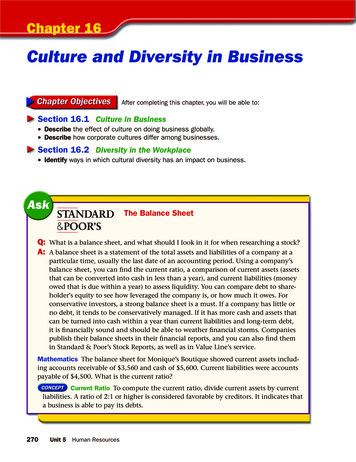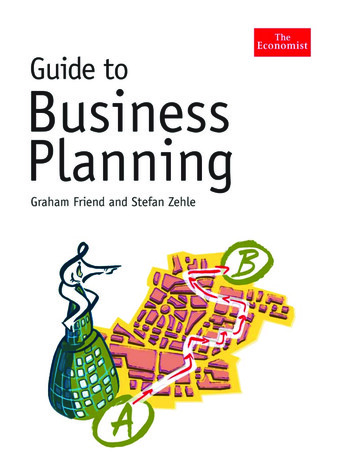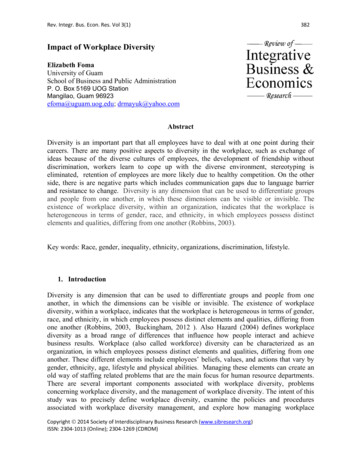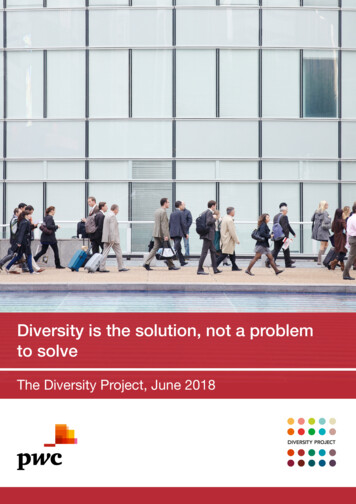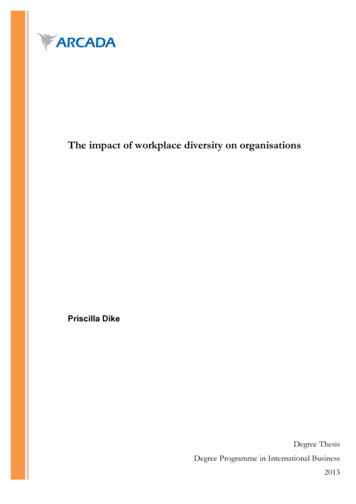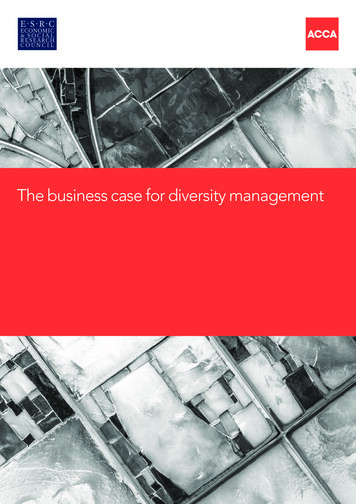
Transcription
The business case for diversity management
About ACCAACCA (the Association of Chartered CertifiedAccountants) is the global body for professionalaccountants. We aim to offer business-relevant, firstchoice qualifications to people of application, abilityand ambition around the world who seek a rewardingcareer in accountancy, finance and management.Founded in 1904, ACCA has consistently held uniquecore values: opportunity, diversity, innovation, integrityand accountability. We believe that accountants bringvalue to economies in all stages of development. Weaim to develop capacity in the profession andencourage the adoption of consistent global standards.Our values are aligned to the needs of employers in allsectors and we ensure that, through our qualifications,we prepare accountants for business. We work to openup the profession to people of all backgrounds andremove artificial barriers to entry, ensuring that ourqualifications and their delivery meet the diverse needsof trainee professionals and their employers.www.accaglobal.comAbout the ESRCThe Economic and Social Research Council (ESRC) isthe UK’s largest organisation for funding research oneconomic and social issues. It supports independent,high-quality research which has an impact on business,the public sector and the third sector. The ESRC’s totalbudget for 2010/11 is 218 million. At any one time itsupports over 4,000 researchers and postgraduatestudents in academic institutions and independentresearch institutes.The ESRC’s research makes a difference: it shapespublic policies and makes businesses, voluntary bodiesand other organisations more effective as well asshaping wider society.www.esrc.ac.uk The Association of Chartered Certified AccountantsSeptember 2014This paper presents researchcommissioned by ACCA and ESRCinto the limitations of currentdiversity management and at whatcould be done to help organisationsbenefit from greater diversity andinclusive cultures.In particular, it considers the roleof the finance function in helpinggather relevant financial and nonfinancial data and developing andimplementing diversity strategies,policies and procedures.
The business case fordiversity managementMustafa ÖzbilginAhu Tatli, Gulce IpekMuhammad Sameer
4
Executive summaryThere is a need for refreshed enthusiasm to fuel effectivediversity management and inclusion in global organisations.This report responds to this challenge and presents ways inwhich organisations can build the business case for speedingup progress towards diversity and inclusion. There is no quickfix for this. Instead, organisations should develop customisedbusiness cases that engage their stakeholders.BACKGROUND TO THE STUDYMaking a robust business case continues to be the first stepin organisational commitment to diversity management. Yetthe evidence for the organisational outcomes of achievingworkforce diversity is mixed, demonstrating both positive andnegative consequences. This is because it is the effectivemanagement of diversity that enables improvements inperformance (Tatli and Özbilgin 2012). Drawing on interviewswith diversity or finance leaders in 22 globally significantorganisations, the report explains how to make a strongbusiness case for diversity management.KEY FINDINGSThere are five key findings from this study. The business case for diversity is expanding its focus. Thisexpansion has been from shareholder value to stakeholdervalue, regulatory context and global value chain. There is growing need to develop an evidence-basedapproach to the business case, to suit the needs oforganisations in different locations and sectors that needto approach diversity in different ways. Organisations should reflect on their stakeholders, thedemands of their business environment and the maturityof their diversity management programme when craftingtheir business case. It is important to ask whose benefitthe business case promotes. Answers to this question canreveal the varying impact that diversity policies may haveon different groups at work. The finance function, with its ability to account forstrategic resources of organisations – one of which is theworkforce, can play an important role in crafting thebusiness case for diversity. Organisations are increasingly moving from best practicesto customised practices, in recognition of the fact thatdiversity requirements are contingent upon a range oforganisational idiosyncrasies.THE BUSINESS CASE FOR DIVERSITY MANAGEMENTTHE BUSINESS CASEThe business case for diversity is an organisationaldiscourse that connects workforce diversity with a set oforganisational outcomes. The business case for diversitymanagement operates at four levels. At each level, thereare different sets of justifications for adopting diversitymanagement practices.Shareholder value: at the shareholder-value level,business case arguments focus on ‘single bottom line’arguments. In this approach, organisations typicallymeasure the contribution of diversity to profitability,return on investment, effective management ofbudget and other resources at work.Stakeholder value: while the shareholder-valueapproach focuses on the ‘single bottom line’, thestakeholder approach focuses on the ‘triple bottomline’ of profits, people, planet. In this approach,organisations typically measure the contribution ofeffective management of diversity to profitability,turnover rates, satisfaction at work and amongconsumers and to the well-being and sustainability ofthe wider social, political and ecological environment.Regulatory context: at the regulatory-context level,organisations recognise the links between effectiveregulation and accruing positive benefits fromdiversity. Regulation may, however, take multipleforms for organisations, including self-regulation,industry-regulation, legal regulation, economicregulation. In this approach, organisations typicallymeasure their compliance with regulations.Global value chain: at this level, the business caseargument connects the management of diversity totransnational and international differences.Organisations typically measure the impact of theparity between different national implementations ofdiversity policy. The organisation at this level does notsimply localise its practices but enhances crossnational learning.5
RECOMMENDATIONSBroaden the business caseOrganisations need to develop a sound understanding of thebusiness case for diversity, including the economic necessityfor widening their talent pool, tackling inequality and nonmeritocratic practices, and establishing inclusive work places.Return on investment measures may be particularly useful forinvolving line managers. An effective business case needs toaccount for shareholder value, stakeholder value, legalcontext, and global value chain, capturing the organisational,sectoral, institutional, social and environmental impact.Business case arguments should advocate not only diversitybut also a culture of inclusion. The business case should movebeyond a narrow concept of short-term returns because thebenefits of diversity are often accrued in the medium andlonger terms.Build the evidence baseOrganisations need to engage in data gathering, monitoringand analysing activities in a systematic way to demonstratethe business case for diversity management in their specificcircumstances. Organisations should identify their availabledata and their new data needs. Building the evidence baserequires a creative flair in relating the strategic priorities ofthe organisation to the possible and actual contributions ofdiversity. Collecting qualitative and quantitative evidence isessential for building a robust business case for an effectivediversity management plan. Organisational diversityapproaches should be sensitive to local contexts whilemeeting national challenges and drawing on transnationaland cross-national learning, which may be garnered throughcorporate communication strategies that target sharing ofgood practice.Master the business caseThe business case should be systemic rather than ‘bolted on’so that diversity management becomes ‘business as usual’.This requires a focus on the long-term gains rather thanquick-fix solutions. The business case arguments shouldengage with the existing projects in the organisation andstretch the imagination and understanding of the project6managers. The business case for diversity should bepromoted through engagement. A complex set of internaland external stakeholders drive organisations to buildbusiness case arguments. In developing a business case, it isimportant to focus on the multiple stakeholders, businessenvironment and the stage of development of the diversityprogramme. If the conditions in the external businessenvironment are supportive, stakeholders are vocal with theirdiversity demands and the diversity programme is mature,the organisation can move towards developing moresophisticated business case arguments.Engage the finance functionDiversity management should be seen as everyone’sresponsibility. Hence the finance function, alongside all otherfunctions, should play a role in the design andimplementation of diversity-management policies. Thefinance function needs to play a proactive and central role inmanaging diversity processes, including data collection,analysis and reporting. Finance professionals’ expertise mayoffer an invaluable resource for the diversity office indeveloping tools for measuring the phenomena that willsupport the business case. Organisations often have a wealthof employee data. The finance function can offer its expertiseto in mining the existing workforce data so as to link diversityand performance. Diversity function and the finance functioncan together explore what the current data reveal aboutdiversity and identify future data needs.Move from best practices to customised practicesTo be effective, diversity management policies andprogrammes need organisation-wide support andcommitment. A strong business case is crucial in convincingall organisational actors about the importance of diversitymanagement. Developing a business case for diversity isabout creating a sense of relevance, urgency and immediacyin order to gain legitimacy and achieve buy-in from seniorexecutives and line managers. All these require theorganisation to move from the pursuit of best practices to thedevelopment of customised practices that are sensitive to thecircumstances of the organisation.
ACTION POINTS FOR CRAFTING A BUSINESS CASEFOR DIVERSITY MANAGEMENTDefine what diversity means for your organisation.Identify the strategic priorities.Know your organisation’s data sources and needs soas to align diversity policy with organisationalpriorities.Take stock of current and new data.Gather data, build trust and demonstrate integrity inthe use of data.Develop a business case by linking diversity data withbusiness outcomes.Achieve commitment for the business case fromstakeholders.Craft diversity strategies that are informed by thebusiness case.Share the responsibility for management of diversityacross the organisation.Monitor the effectiveness of the business case.THE BUSINESS CASE FOR DIVERSITY MANAGEMENT7
1. IntroductionBuilding a robust business case is the first step inorganisational commitment to diversity management. Theevidence shows that effective management of diversity is asuccess factor for organisations (King et al., 2012; Özbilginand Tatli, 2008). There exists a well-developed literature onthe effects of diversity on the organisational performance.Earlier studies explored the link between different diversitydimensions (eg race/ethnicity, gender, age, nationality,tenure, functional background, education) and organisationaloutcomes (eg innovation, team performance andeffectiveness, decision making quality, internationalisation,corporate reputation, and financial performance). Yet theresults are inconclusive, with research demonstratingconflicting diversity outcomes (see Urwin et al. 2013). It is theeffective management of diversity that is crucial. Drawing on22 case studies in globally significant organisations, thepresent report outlines the state-of-the-art practices increating the business case for diversity management. .AIMS OF THE RESEARCHThe report answers five critical questions.Two of these relate to broadening the business case. What is the existing evidence base on workplace diversityand its impact on business performance and innovation? What motivates business diversity policy?A third relates to building the evidence base. Through what means does the evidence suggest thatincreased diversity can result in improved businessperformance? How is this manifested?The fourth is concerned with mastering the business case. How do organisations understand the business case, plandiversity into their strategies, and implement and monitordiversity policy in line with their business case?Lastly, there is the question of moving from best practice tocustomised practice. 8What does ‘customised practice’ in policy andimplementation look like?METHODOLOGYThe study involved a literature review and interviews withorganisational leaders, and generated 22 interviews with casestudy organisations and one focus group with SMEs. Inselecting organisations for inclusion in the research, thesector, size, country of origin and diversity sophistication levelwere taken into account. Through the case studies, the reportpresents the complexity of the business case for diversitymanagement around the world. In the selected organisations,interviewees were either a senior diversity practitioner or asenior finance leader.
2. The finance function and the business case for diversityDiversity management has traditionally been associated withhuman resource management and therefore the role of thefinance function in managing diversity has not been examinedpreviously. In order to fill this gap, we explore the role that thefinance function plays in managing diversity and mastering
benefits of diversity are often accrued in the medium and longer terms. Build the evidence base Organisations need to engage in data gathering, monitoring and analysing activities in a systematic way to demonstrate the business case for diversity management in their specific circumstances. Organisations should identify their available data and their new data needs. Building the evidence

